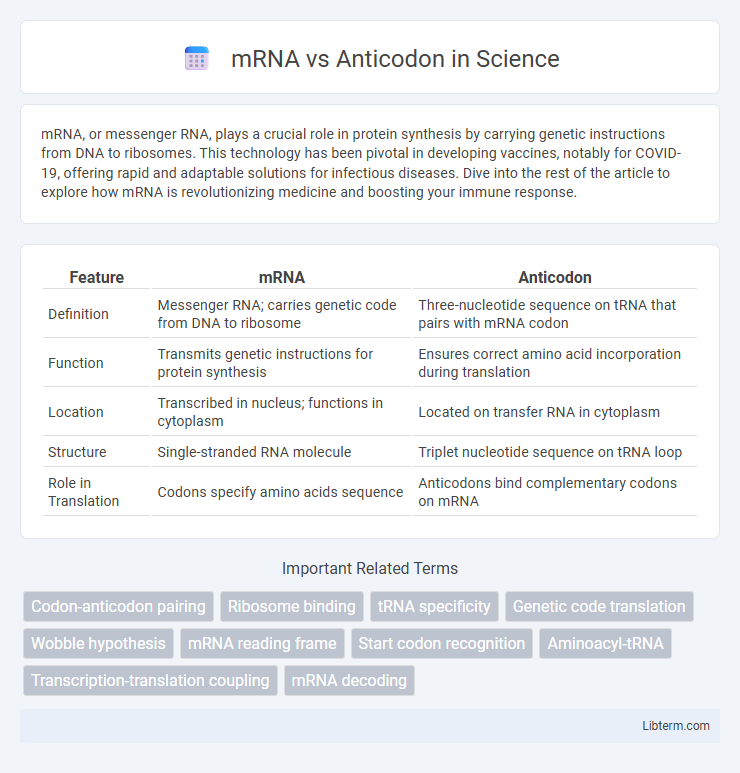mRNA, or messenger RNA, plays a crucial role in protein synthesis by carrying genetic instructions from DNA to ribosomes. This technology has been pivotal in developing vaccines, notably for COVID-19, offering rapid and adaptable solutions for infectious diseases. Dive into the rest of the article to explore how mRNA is revolutionizing medicine and boosting your immune response.
Table of Comparison
| Feature | mRNA | Anticodon |
|---|---|---|
| Definition | Messenger RNA; carries genetic code from DNA to ribosome | Three-nucleotide sequence on tRNA that pairs with mRNA codon |
| Function | Transmits genetic instructions for protein synthesis | Ensures correct amino acid incorporation during translation |
| Location | Transcribed in nucleus; functions in cytoplasm | Located on transfer RNA in cytoplasm |
| Structure | Single-stranded RNA molecule | Triplet nucleotide sequence on tRNA loop |
| Role in Translation | Codons specify amino acids sequence | Anticodons bind complementary codons on mRNA |
Introduction to mRNA and Anticodon
mRNA, or messenger RNA, acts as the molecular blueprint that carries genetic information from DNA to ribosomes for protein synthesis. The anticodon is a specific sequence of three nucleotides found on tRNA molecules, responsible for matching the complementary codon on mRNA during translation. This precise pairing between mRNA codon and tRNA anticodon ensures accurate incorporation of amino acids into the growing polypeptide chain.
Molecular Structure: mRNA vs Anticodon
mRNA (messenger RNA) is a single-stranded nucleic acid composed of ribonucleotides arranged in a linear sequence that encodes the genetic information for protein synthesis. The anticodon is a specific trinucleotide sequence located on a tRNA molecule, designed to complement a corresponding codon on the mRNA strand during translation. The molecular structure of mRNA facilitates the transmission of genetic codes, while the anticodon's triplet sequence ensures accurate amino acid alignment through base pairing with mRNA codons.
Functional Roles in Protein Synthesis
mRNA carries the genetic code from DNA to the ribosome, serving as a template for protein synthesis by specifying the sequence of amino acids. The anticodon, a sequence of three nucleotides on tRNA, pairs with the complementary codon on mRNA to ensure the correct amino acid is incorporated into the growing polypeptide chain. This precise codon-anticodon interaction is essential for translating genetic information into functional proteins.
mRNA: Messenger and Blueprint
mRNA, or messenger RNA, serves as the crucial blueprint in protein synthesis by carrying genetic information from DNA to ribosomes for translation. This single-stranded molecule contains codons, sequences of three nucleotides that specify amino acids, enabling precise assembly of proteins. In contrast, the anticodon is part of tRNA and functions to match these mRNA codons during translation, ensuring accurate incorporation of amino acids.
Anticodon: Decoder in Translation
The anticodon is a crucial trinucleotide sequence on transfer RNA (tRNA) that decodes the messenger RNA (mRNA) codon during protein synthesis by base pairing specifically with the complementary mRNA codon. This precise interaction ensures the correct amino acid is incorporated into the growing polypeptide chain, maintaining the fidelity of genetic translation. By accurately interpreting the mRNA sequence, the anticodon facilitates the conversion of genetic information into functional proteins essential for cellular processes.
Transcription: Creation of mRNA
During transcription, mRNA is synthesized from a DNA template strand by RNA polymerase, which reads the DNA sequence and assembles a complementary strand of messenger RNA. The mRNA sequence is composed of codons, each consisting of three nucleotides that correspond to specific amino acids during translation. Unlike the anticodon, which is a three-nucleotide sequence found on tRNA that pairs with the mRNA codon during protein synthesis, mRNA serves as the direct template for the genetic code transcribed from DNA.
Translation: Anticodon and Ribosome Interaction
During translation, the anticodon of a tRNA molecule pairs specifically with the complementary codon on the mRNA strand within the ribosome's decoding center. This precise base-pairing ensures correct amino acid incorporation into the growing polypeptide chain, guided by codon-anticodon interactions. Ribosomal RNA and proteins stabilize this complex, facilitating efficient and accurate protein synthesis.
Error Correction and Fidelity Mechanisms
mRNA carries the genetic code from DNA to the ribosome, where it is translated into a protein sequence, while an anticodon is a set of three nucleotides on tRNA that pairs with the complementary codon on mRNA during translation. Error correction mechanisms include proofreading by aminoacyl-tRNA synthetases, which ensure correct amino acid attachment to tRNA, and ribosomal fidelity checks that monitor correct codon-anticodon pairing to minimize translation errors. mRNA itself relies on processes like nonsense-mediated decay to detect and degrade faulty transcripts, enhancing overall translation fidelity and accurate protein synthesis.
Genetic Code and Codon Recognition
mRNA carries the genetic code from DNA in the form of codons, sequences of three nucleotides that specify particular amino acids during protein synthesis. The anticodon, located on tRNA, is a complementary three-nucleotide sequence that recognizes and pairs with the mRNA codon through base-pairing rules, ensuring accurate translation of the genetic code. This codon-anticodon interaction is critical for decoding mRNA into a precise amino acid sequence, directly influencing the fidelity of protein assembly.
Biomedical Applications and Research Advances
mRNA serves as the essential genetic blueprint transcribed from DNA, guiding protein synthesis by conveying codon sequences that specify amino acids in ribosomal translation, while the anticodon is the complementary trinucleotide sequence on tRNA that ensures accurate amino acid incorporation during protein assembly. Recent biomedical research advances leverage synthetic mRNA technologies for vaccines, such as mRNA-based COVID-19 vaccines, enabling rapid immune response development, whereas anticodon engineering has propelled innovations in genetic code expansion, allowing incorporation of non-standard amino acids to enhance therapeutic protein functionality. These breakthroughs underscore the critical roles of mRNA stability and anticodon specificity in optimizing gene expression control, targeted drug design, and personalized medicine applications.
mRNA Infographic

 libterm.com
libterm.com